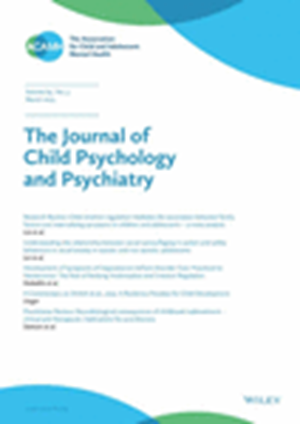12种罕见神经发育障碍儿童的沟通能力谱:一项与照顾者的定性研究。
IF 7
1区 医学
Q1 PSYCHIATRY
引用次数: 0
摘要
背景:我们的目的是通过集中照顾者和家庭的视角来更新患有罕见神经发育障碍(ndd)儿童沟通能力的现有模型。该项目是一项更大的倡议的一部分,旨在改善临床试验背景下这些儿童沟通能力的测量。方法对12例ndd患儿的临床专家和护理人员进行概念启发访谈,重点探讨基于观察者报告的沟通能力(ORCA)量表对沟通能力的广义定义,包括不同的沟通方式,涵盖表达性、接受性和语用性沟通概念。对定性数据进行了内容分析和主题分析。结果共对12个ndd的护理人员和9名临床医生进行了115次访谈。ndd中经常提到的概念包括请求一个对象、拒绝一个对象、响应熟悉的方向和寻求注意。就每个沟通概念所描述的具体沟通行为而言,在NDD组内部和组之间存在显著的异质性。一个常见的例子是请求;孩子们使用口头语言、手势、手语、眼睛注视、身体运动和辅助交流来要求他们想要的东西。不属于现有模式的新交流概念是(1)感觉、情绪和身体感觉,(2)评论喜欢和不喜欢,(3)沟通和理解幽默。结论:给予者提供了孩子日常交流的详细而细致的画面。在访谈中,照顾者讨论的沟通概念与现有的沟通能力概念模型有相当大的重叠。一些新发现的概念强调需要进一步调整模型,并在临床试验中自信地测量这些个体的沟通能力之前,对任何临床结果评估进行后续验证。本文章由计算机程序翻译,如有差异,请以英文原文为准。
The spectrum of communication abilities in children with 12 rare neurodevelopmental disorders: a qualitative study with caregivers.
BACKGROUND
Our aim was to update an existing model of communication ability for children with rare neurodevelopmental disorders (NDDs) by centring caregiver and family perspectives. This project is part of a larger initiative to improve the measurement of communication ability for these children in the context of clinical trials.
METHODS
We conducted concept elicitation interviews with purposively selected clinical experts and caregivers of children with 12 NDDs, focusing on a broad definition of communication ability based on the Observer-Reported Communication Ability (ORCA) measure, which is inclusive of different communication modalities and covers expressive, receptive and pragmatic communication concepts. Content-based and thematic analysis was performed on the qualitative data.
RESULTS
Altogether, 115 interviews were conducted with caregivers across the 12 NDDs and with 9 clinicians. Commonly mentioned concepts across NDDs included requesting an object, refusing an object, responding to familiar directions and seeking attention. There was notable heterogeneity within and across NDD groups in terms of the specific communication behaviours described for each communication concept. One common example was requesting; children used verbal speech, gestures, sign language, eye gaze, body movements and augmentative and assistive communication to ask for what they wanted. Novel communication concepts identified that were not part of the existing model were (1) feelings, emotions, and bodily sensations, (2) commenting on likes and dislikes, and (3) communicating and understanding humour.
CONCLUSIONS
Caregivers offered a detailed and nuanced picture of their child's day-to-day communication. There was a considerable overlap between the communication concepts discussed by caregivers in the interviews and the existing conceptual model of communication ability. Some newly identified concepts underscore the need for further adaptation of the model and subsequent validation of any clinical outcome assessment before communication ability can be confidently measured for these individuals in clinical trials.
求助全文
通过发布文献求助,成功后即可免费获取论文全文。
去求助
来源期刊
CiteScore
13.80
自引率
5.30%
发文量
169
审稿时长
1 months
期刊介绍:
The Journal of Child Psychology and Psychiatry (JCPP) is a highly regarded international publication that focuses on the fields of child and adolescent psychology and psychiatry. It is recognized for publishing top-tier, clinically relevant research across various disciplines related to these areas. JCPP has a broad global readership and covers a diverse range of topics, including:
Epidemiology: Studies on the prevalence and distribution of mental health issues in children and adolescents.
Diagnosis: Research on the identification and classification of childhood disorders.
Treatments: Psychotherapeutic and psychopharmacological interventions for child and adolescent mental health.
Behavior and Cognition: Studies on the behavioral and cognitive aspects of childhood disorders.
Neuroscience and Neurobiology: Research on the neural and biological underpinnings of child mental health.
Genetics: Genetic factors contributing to the development of childhood disorders.
JCPP serves as a platform for integrating empirical research, clinical studies, and high-quality reviews from diverse perspectives, theoretical viewpoints, and disciplines. This interdisciplinary approach is a key feature of the journal, as it fosters a comprehensive understanding of child and adolescent mental health.
The Journal of Child Psychology and Psychiatry is published 12 times a year and is affiliated with the Association for Child and Adolescent Mental Health (ACAMH), which supports the journal's mission to advance knowledge and practice in the field of child and adolescent mental health.

 求助内容:
求助内容: 应助结果提醒方式:
应助结果提醒方式:


